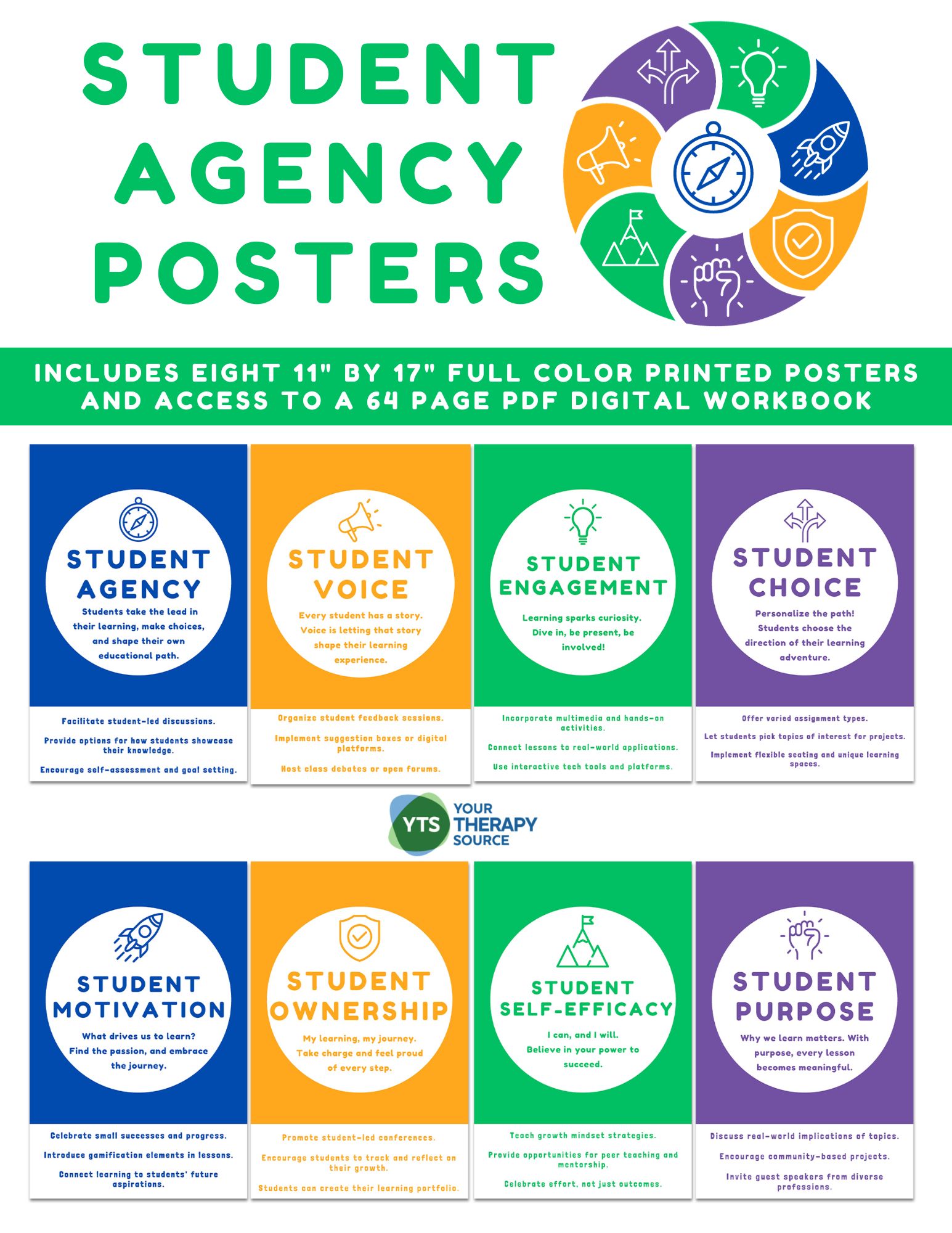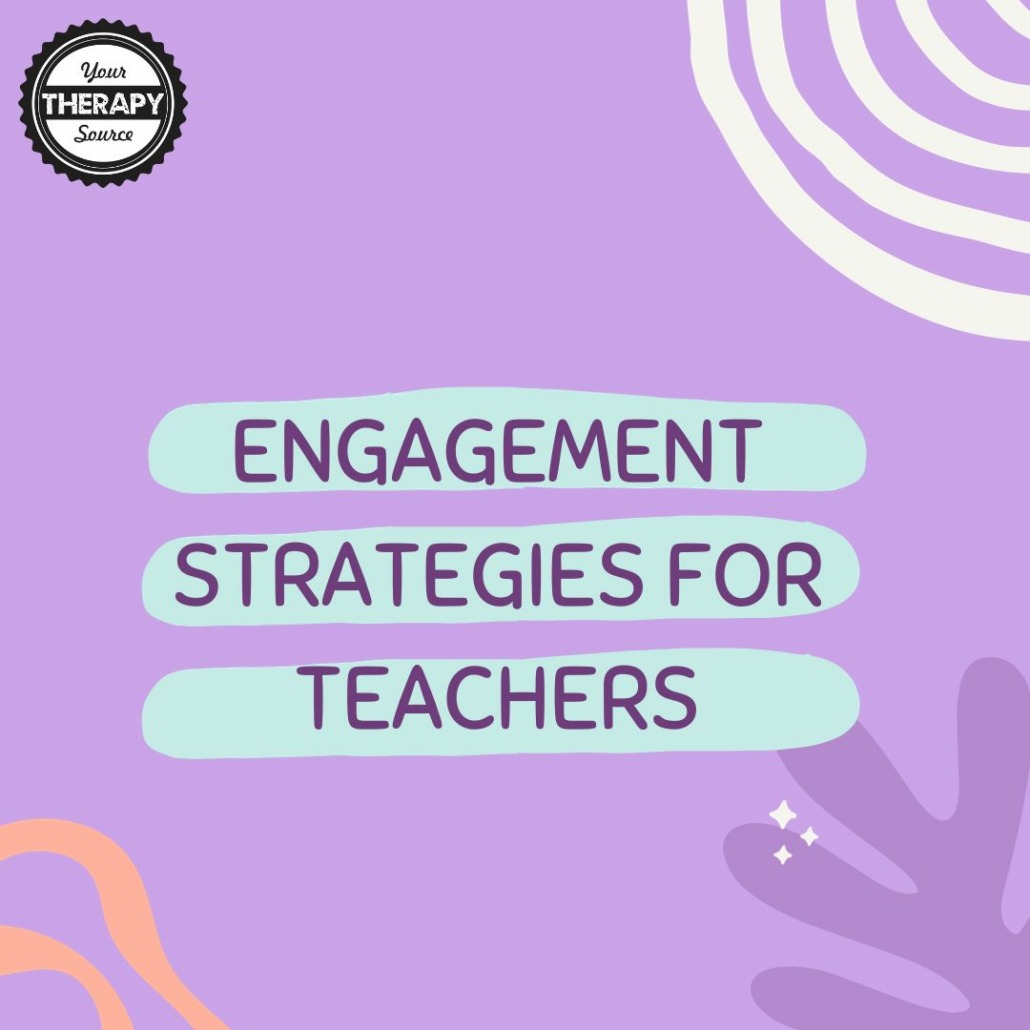Engagement Strategies for Teachers

Engagement strategies for teachers are the key to effective teaching and learning. When students are actively engaged in their lessons, they are more likely to understand, retain, and apply what they’ve learned.
As educators, it’s our responsibility to employ a variety of engagement strategies to keep students motivated and attentive. Exploring different types of engagement strategies for teachers is important so that teachers can improve engagement in the classroom.

Student Agency Poster Packet + BONUS Digital PDF Workbook
TYPES OF ENGAGEMENT STRATEGIES FOR TEACHERS
Engagement strategies for teachers come in various forms, encompassing intellectual, emotional, and behavioral aspects. It is a very important part of student agency as well. Here are some types of student engagement strategies:
Active Learning
Encourage students to be active participants in the learning process rather than passive recipients of instructions. Active learning can take many forms, including discussions, problem-solving activities, and hands-on experiments.
Collaboration
Create opportunities for students to work in small groups or pairs. Collaborative activities foster peer interactions, enabling students to learn from their classmates and exchange ideas.
Formative Assessment
Use formative assessment techniques to gauge students’ understanding of the lesson material. These assessments can take the form of quizzes, polls, or open-ended questions that allow you to adjust your teaching based on student responses.
Think-Pair-Share
This engagement strategy encourages critical thinking and active participation. Pose a question, have students think about it individually, discuss it with a partner, and then share their thoughts with the class.
Brain Breaks
Recognize the importance of short breaks during the lesson. Incorporate brain breaks, which are brief activities or stretches, to help students recharge and refocus their attention. With brain breaks, you’ll also be able to help students focus in the classroom better.
Real-World Connections
Relate the lesson material to real-life scenarios and experiences. When students see the relevance of what they are learning, they are more likely to be engaged.
Visual Aids
Utilize visual aids such as whiteboards, charts, and diagrams to make complex topics more accessible. Visual learners often benefit greatly from these resources.
Gallery Walk
Organize a gallery walk, where students move around the classroom to view and discuss different pieces of information or projects. This fosters active exploration and social interactions.
Ownership
Give students a sense of ownership over their learning. Allow them to choose topics or projects that align with their interests, providing a sense of autonomy.
Emotional Engagement
Establish a positive and supportive classroom environment. Building rapport with students, showing empathy, and addressing their emotional needs can enhance emotional engagement. Teaching students effective emotional regulation can also help with this type of engagement.
Behavioral Engagement
Set clear expectations and routines in the classroom to minimize distractions and disruptions. Consistency in classroom management can help maintain students’ behavioral engagement.

Self-Advocacy for Students
IMPROVING ENGAGEMENT IN THE CLASSROOM
Now that we’ve discussed types of engagement strategies, let’s delve into how teachers can improve engagement in the classroom:
Know Your Students
Understanding your students’ learning preferences, interests, and perspectives is essential. Tailor your teaching strategies to cater to their individual needs and motivations.
Set Clear Learning Objectives
Communicate clear learning objectives at the beginning of each lesson. Students are more likely to engage with the material when they know what they are expected to learn.
Vary Instructional Methods
Avoid monotony in your lessons. Use a mix of instructional methods, including lectures, group discussions, hands-on activities, and technology, to cater to diverse learning styles.
Provide Timely Feedback
Regularly provide feedback on students’ work and progress. Constructive feedback helps students understand their strengths and areas for improvement, motivating them to excel.
Encourage Critical Thinking
Challenge students to think critically and ask questions. Encourage them to analyze information, problem-solve, and draw their own conclusions.
Promote Student Participation
Create a classroom culture where every student feels valued and encouraged to participate. Use techniques like think-pair-share and brainstorming to involve all students.
Use Technology Wisely
Leverage technology as a resource to enhance engagement, especially in online learning environments. Interactive platforms, multimedia, and educational apps can make learning more engaging.
Incorporate Real-Life Examples
Show students how the topics they are studying apply to the real world. This connection can spark curiosity and motivation to learn.
Peer Collaboration
Encourage peer collaboration and peer teaching. Students often learn better from their peers and can support each other’s understanding of complex concepts.
Celebrate Achievements
Acknowledge and celebrate students’ achievements, both big and small. Positive reinforcement, such as praise and rewards, can boost motivation and engagement.
Reflection
Provide opportunities for students to reflect on their learning process. Ask them to articulate their understandings in their own words and set goals for improvement.
EXAMPLES OF ENGAGEMENT STRATEGIES FOR TEACHERS IN EDUCATION
To illustrate these engagement strategies in action, let’s explore some real-life examples of engagement in education:
Small Group Work
In a math class, the teacher divides students into small groups to solve complex problems together. This promotes collaboration and allows students to learn from their peers.
Think-Pair-Share
During a history lesson, the teacher poses a thought-provoking question about a historical event. Students first reflect on their own, then discuss it with a partner, and finally share their thoughts with the class. This encourages critical thinking and active participation.
Online Learning Tools
A science teacher uses interactive simulations and virtual labs in an online learning environment to help students explore scientific concepts hands-on. This technology-based approach keeps students engaged and curious.
Gallery Walk
As part of an English assignment, students create posters summarizing different chapters of a novel they’ve read. They then participate in a gallery walk, where they analyze and discuss their classmates’ posters. This activity fosters active exploration and social interactions.
Real-World Projects
A high school economics class tasks students with creating a business plan for a product or service. This project-based learning approach allows students to apply economic principles to a real-life scenario, increasing engagement and ownership of their learning.
Visual Aids
A biology teacher uses diagrams and charts to illustrate complex biological processes. Visual learners grasp the material more easily, enhancing their engagement.
Peer Teaching
In a literature class, students take turns leading discussions about different literary works. This not only encourages participation but also deepens their understanding of the subject matter.
Emotional Engagement
An elementary school teacher takes time to build a strong rapport with each student, creating a supportive and positive classroom environment. This emotional engagement helps students feel safe and motivated to learn. They also learn effective self regulation strategies that aid in their emotional growth.
Behavioral Engagement
A middle school teacher establishes clear routines and criteria for classroom behavior. Consistency in classroom management reduces distractions and maintains students’ attention.
Incorporating these engagement strategies into your teaching practices can significantly enhance the learning experience for your students, whether you are working with young kids in elementary school or older students in high school or beyond.
Engagement strategies for teachers play a pivotal role in shaping students’ learning experiences and outcomes. Educators can create dynamic and effective classrooms by employing a diverse range of engagement strategies encompassing active learning, collaboration, formative assessment, and more. Understanding the needs and interests of students, setting clear objectives, and leveraging technology are crucial elements in improving student engagement.



